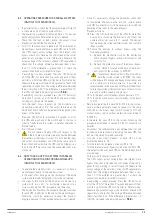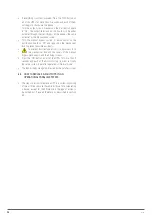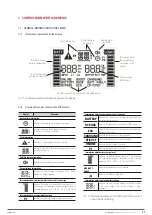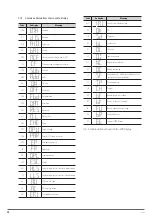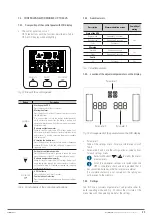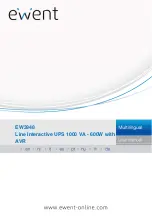
14
SALICRU
are exposed, must be respected, otherwise the warranty
may be invalidated.
•
After this period, connect the device to the mains together
with the battery unit if applicable, start it according to the
instructions described in this manual and charge for 12
hours.
In parallel systems, it is not necessary to interconnect
devices before battery charging. Each of them can be
treated independently to charge them.
•
Then shut down the device, disconnect it and store the UPS
and batteries in their original packaging, noting the new
date for recharging the batteries on a document as a record
or even on the packaging itself.
•
Do not store the devices where the ambient temperature
exceeds 50ºC or drops below -15ºC, as this may cause
degradation of the electrical characteristics of the batteries.
5.1.3. Unpacking.
•
The packaging of the device consists of a cardboard box,
expanded polystyrene (EPS) or polyethylene foam (EPE)
corners, polyethylene cover and strapping, all of which are
recyclable materials; consequently, if it requires disposal,
it must be carried out in accordance with current laws. We
recommend keeping the packaging in case it needs to be
used in the future.
•
Proceed as follows:
Cut the straps around the cardboard box.
Remove the accessories (cables, brackets, etc. )
Remove the device or battery module from the box with
the help, if necessary, of a second person depending
on the weight of the model or using appropriate
mechanical means.
Remove the protective corners from the device and the
plastic bag.
Do not leave the plastic bag within the reach of
children to avoid danger of suffocation.
Inspect the device before proceeding and, in the event
of finding damage, contact the supplier or, failing that,
our firm.
5.1.4. Transport to the site.
It is recommended to transport the UPS by means of a
pallet jack or the most appropriate method considering the
distance between the two points.
If the distance is considerable, it is recommended to
transport the device in its packaging to the installation site
and then unpack it.
5.1.5. Siting, immobilising and considerations.
•
All TWIN RT2 series UPSs are designed to be mounted as
a tower model -vertical arrangement of the device- or rack
-horizontal arrangement- for installation in 19” cabinets,
regardless of whether they operate independently or as
parallel systems, whether or not they have a battery module
or whether the available backup is standard or extended
(greater number of battery modules).
Follow the instructions indicated in the sections relating to
either of the two possibilities, according to the particular
configuration of your device.
•
Figs. 5 to 11 show, by way of example, illustrations of a
device with or without battery module. These illustrations
provide help and guidance in the steps to follow, but the
instructions are not intended to refer to a single model,
although, in practice, the actions to be carried out are
always the same for all of them.
•
For all instructions regarding connections, refer to section 5.2.
5.1.5.1. Rotation of the control panel with LCD display.
Fig. 5.
Rotation of the control panel with LCD display on
the plastic front trim.
•
To facilitate the reading of messages on the display when
the device is installed vertically, it is possible to rotate the
control panel clockwise by 90º (see Fig. 5).
•
Likewise, reverse the rotation of the control panel if a
device arranged as a tower needs to be installed as a rack.
In this case, the rotation of the control panel will be anti-
clockwise.
•
Proceed as follows:
Insert fingertips into the recesses of the plastic trim
around the display and pull outwards.
Rotate the control panel with LCD display 90º to the
right with respect to its initial position and insert it back
into the front.
5.1.5.2. Vertical tower-type mounting.
•
Rotate the control panel according to section 5.1.5.1.
•
Take the 4 pieces of plastic supplied with the device and
join them together in twos to obtain two bases.
•
Place the UPS upright between the two bases at a distance

























